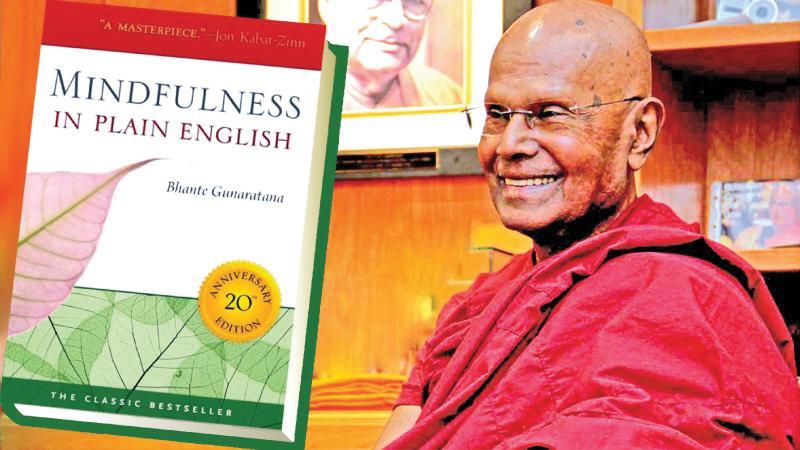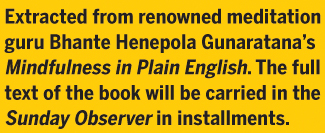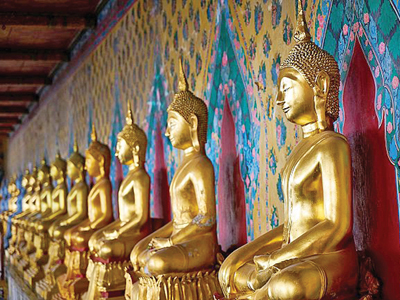
Our human perceptual habits are remarkably stupid in some ways. We tune out 99 percent of all the sensory stimuli we actually receive, and we solidify the remainder into discrete mental objects. Then we react to those mental objects in programmed, habitual ways.
 An example: There you are, sitting alone in the stillness of a peaceful night. A dog barks in the distance, which, in itself, is neither good nor bad. Up out of that sea of silence come surging waves of sonic vibration. You start to hear the lovely complex patterns, and they are turned into scintillating electronic stimulations within the nervous system. The process should be used as an experience of impermanence, unsatisfactoriness, and selflessness. We humans tend to ignore it totally. Instead, we solidify that perception into a mental object. We paste a mental picture on it and launch into a series of emotional and conceptual reactions to it. “There is that dog again. He is always barking at night. What a nuisance. Every night he is a real bother. Somebody should do something.
An example: There you are, sitting alone in the stillness of a peaceful night. A dog barks in the distance, which, in itself, is neither good nor bad. Up out of that sea of silence come surging waves of sonic vibration. You start to hear the lovely complex patterns, and they are turned into scintillating electronic stimulations within the nervous system. The process should be used as an experience of impermanence, unsatisfactoriness, and selflessness. We humans tend to ignore it totally. Instead, we solidify that perception into a mental object. We paste a mental picture on it and launch into a series of emotional and conceptual reactions to it. “There is that dog again. He is always barking at night. What a nuisance. Every night he is a real bother. Somebody should do something.
Maybe I should call a cop. No, a dog catcher—I’ll call the pound. No, maybe I’ll just write a nasty letter to the guy who owns that dog. No, too much trouble. I’ll just get ear plugs.” These are just perceptual mental habits. You learn to respond this way as a child by copying the perceptual habits of those around you. These perceptual responses are not inherent in the structure of the nervous system. The circuits are there, but this is not the only way that our mental machinery can be used. That which has been learned can be unlearned. The first step is to realise what you are doing as you are doing it, to stand back and quietly watch.
Backward view of life
From the Buddhist perspective, we humans have a backward view of life. We look at what is actually the cause of suffering and see it as happiness. The cause of suffering is that desire-aversion syndrome that we spoke of earlier. Up pops a perception. It could be anything—an attractive woman, a handsome guy, a speedboat, the aroma of baking bread, a truck tailgating you, anything. Whatever it is, the very next thing we do is to react to the stimulus with a feeling about it.
 For example, take worry. We worry a lot. Worry itself is the problem. Worry is a process; it has steps. Anxiety is not just a state of existence but a procedure. What you’ve got to do is to look at the very beginning of that procedure, those initial stages before the process has built up a head of steam.
For example, take worry. We worry a lot. Worry itself is the problem. Worry is a process; it has steps. Anxiety is not just a state of existence but a procedure. What you’ve got to do is to look at the very beginning of that procedure, those initial stages before the process has built up a head of steam.
The very first link of the worry chain is the grasping-rejecting reaction. As soon as a phenomenon pops into the mind, we try mentally to grab onto it or push it away. That sets the worry response in motion. Luckily, there is a handy little tool called Vipassana meditation that you can use to short-circuit the whole mechanism.
Vipassana meditation teaches us how to scrutinise our own perceptual process with great precision. We learn to watch the arising of thought and perception with a feeling of serene detachment. We learn to view our own reactions to stimuli with calmness and clarity. We begin to see ourselves reacting without getting caught up in the reactions themselves. The obsessive nature of thought slowly dies. We can still get married. We can still get out of the path of the truck.
But we don’t need to go through hell over either one.
This escape from the obsessive nature of thought produces a whole new view of reality. It is a complete paradigm shift, a total change in the perceptual mechanism. It brings with it the bliss of emancipation from obsessions. Because of these advantages, Buddhism views this way of looking at things as a correct view of life; Buddhist texts call it seeing things as they really are. Vipassana meditation is a set of training procedures that gradually open us to this new view of reality as it truly is. Along with this new reality goes a new view of that most central aspect of reality: “me.” A close inspection reveals that we have done the same thing to “me” that we have done to all other perceptions.
We have taken a flowing vortex of thought, feeling, and sensation and solidified that into a mental construct. Then we have stuck a label onto it: “me.” Forever after, we treat it as if it were a static and enduring entity. We view it as a thing separate from all other things. We pinch ourselves off from the rest of that process of eternal change that is the universe, and then we grieve over how lonely we feel. We ignore our inherent connectedness to all other beings and decide that “I” have to get more for “me”; then we marvel at how greedy and insensitive human beings are. And on it goes. Every evil deed, every example of heartlessness in the world, stems directly from this false sense of “me” as distinct from everything else.
If you explode the illusion of that one concept, your whole universe changes.
Process
Don’t expect to be able to do this overnight, though. You spent your whole life building up that concept, reinforcing it with every thought, word, and deed over all those years. It is not going to evaporate instantly. But it will pass if you give it enough time and attention. Vipassana meditation is a process by which that concept is dissolved. Little by little, you chip away at it, just by observing it.
The “I” concept is a process. It is something we are constantly doing. With Vipassana we learn to see that we are doing it, when we are doing it, and how we are doing it. Then that mindset moves and fades away, like a cloud passing through a clear sky. We are left in a state where we can decide to do it or not, whichever seems appropriate to the situation. The compulsiveness is gone: now we have a choice.
These are all major insights. Each one is a deep-reaching understanding of one of the fundamental issues of human existence. They do not occur quickly, nor without considerable effort. But the payoff is big. They lead to a total transformation of your life. Every second of your existence thereafter is changed. The meditator who pushes all the way down this track achieves perfect mental health, a pure love for all that lives, and complete cessation of suffering.
That is no small goal. But you don’t have to go the whole way to reap benefits. The benefits start right away, and they pile up over the years. It is a cumulative function: the more you sit, the more you learn about the real nature of your own existence. The more hours you spend in meditation, the greater your ability to calmly observe every impulse and intention, thought and emotion, just as it arises in the mind.
Your progress to liberation is measured in hours on the cushion. And you can stop during the process any time you feel you’ve had enough. There is no mandating rule but your own desire to see the true quality of life, to enhance your own existence and that of others. Vipassana meditation is inherently experiential, not theoretical.
In the practice of meditation you become sensitive to the actual experience of living, to how things actually feel. You do not sit around developing sublime thoughts about living. You live. Vipassana meditation, more than anything else, is learning to live.
